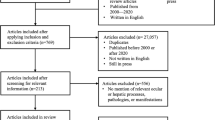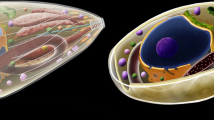Abstract
Sequential clinical examination was carried out upon the eyes of mice that had been infected in utero withToxoplasma gondii. Three patterns of clinical disease were seen. First, crystalliform cataracts, which either remained unchanged in character or occasionally became more extensive, were observed. Second, acute uveitis occurred in a small proportion of eyes, progressing into a chronic inflammatory disease with secondary opaque cataract. The third pattern comprised multiple discrete foci of deep retinal disturbance. It is suggested that these lesions were attributable to focal macrophage clusters in the sub-retinal space with overlying dome-shaped elevations of the photoreceptor matrix. The severity of disease, as assessed clinically, correlated with the underlying histopathology but not with the serological titres againstToxoplasma. Immunocytochemical staining forToxoplasma antigen revealed only intra-retinalToxoplasma cysts, but no free organisms or extracystic antigen were demonstrated. Selective photoreceptor destruction was the most prominent histopathological feature, implicating auto-immune mechanisms of tissue destruction.
Similar content being viewed by others
References
Agarwal LP, Sharma OP, Batta RK, Prakash O (1967) Experimental ocular toxoplasmosis. II. systemic inoculation. Orient Arch Ophthalmol 5:198–204
Ashton N (1979) Ocular toxoplasmosis in wallabies (Macropus rufogriseus). Am J Ophthalmol 88:322–332
Barber AN, Willis J, Afeman C (1961) Changes in the lens induced by maternal hypersensitivity in mice. Am J Ophthalmol 51:949–955
Bloch-Michel E, Campinchi R, Muller JY, Biraghi M, Sales J (1974) HLA antigens and uveitis with special reference to Behcet's disease, chronic herpes simplex, toxoplasmosis and recurrent acute anterior uveitis. In: Silverstein AM, O'Connor GR (eds) Immunology and immunopathology of the eye. Masson, New York
Buyukmihci N, Marsh RF, Albert DM (1977) Ocular effects of scrapie agent in hamsters: preliminary observations. Invest Ophthalmol Vis Sci 16:319–324
del Cerro M, Grover DA, Monjan AA, Pfau CJ, Dematte JE (1982) Chronic retinitis in rats infected as neonates with lymphocytic choriomeningitis virus: a clinical, histopathologic and electroretinographic study. Invest Ophthalmol Vis Sci 23:697–714
Desmonts C, Remington JS (1980) Direct agglutination test for diagnosis ofToxoplasma infection: method for increasing sensitivity and specificity. J Clin Microbiol 11:562–568
Dutton GN, Hay J (1983) Toxoplasmic retinochoroiditis, current concepts in pathogenesis. Trans Ophthalmol Soc UK 103:503–507
Dutton GN, Hay J, Hair DM, Kerrigan P (1984a) Photography of the retina in mice congenitally infected withToxoplasma gondii. Ann Trop Med Parasitol 78:435–437
Dutton GN, Hay J, Ralston J (1984b) The immunocytochemical demonstration ofToxoplasma within the eyes of congenitally infected mice. Ann Trop Med Parasitol 78:431–433
Frenkel JK (1955) Ocular lesions in hamsters with chronicToxoplasma andBesnoita infection. Am J Ophthalmol 39:203–225
Frenkel JK (1961) Pathogenesis of toxoplasmosis with a consideration of cyst rupture inBesnoita infection. Surv Ophthalmol 6:799–825
Friedman CT, Knox DL (1969) Variations in recurrent active toxoplasmic retinochoroiditis. Arch Ophthalmol 81:481–493
Ghafour SYA, Smith HV, Lee WR, Quinn R, Girdwood RWA (1984) Experimental ocular toxocariasis: a mouse model. Br J Ophtholmol 68:89–96
Gibbons JD (1971) Nonparametric statistical analysis. McGraw-Hill Kogakusha Ltd, Tokyo
Gifford SR, Lucie LH (1927) Sympathetic uveitis caused by the virus of herpex simplex. Report of experiments. JAMA 88:465–472
Graham DI, Hay J, Hutchison WM, Siim JC (1984) Encephalitis in mice with congenital ocular toxoplasmosis. J Pathol 142:265–277
Hay J, Kerrigan P (1981) Photography of cataract in mice congenitally infected withToxoplasma gondii. Ann Trop Med Parasitol 76:363–365
Hay J, Hutchison WM, Lee WR, Siim J (1981) Cataract in mice congenitally infected withToxoplasma gondii. Ann Trop Med Parasitol 75:455–457
Hay J, Aitken PP, Hutchison WM, Graham DI (1983) The effect of congenital and adult acquiredToxoplasma infections on the motor performance of mice. Ann Trop Med Parasitol 77:261–277
Hutchison WM, Hay J, Lee WR, Siim JC (1983) A study of cataract in murine congenital toxoplasmosis. Ann Trop Med Parasitol 76:53–70
KrámĂr J, Vrabec F (1960) The inoculation of parasites Toxoplasma gondii into the eyes of albino rats. Cesk Parasitol 7:245–250
Krey HF, Ludwig H, Boschek CB (1979) Multifocal retinopathy in Borna disease virus infected rabbits. Am J Ophthalmol 87:157–164
Lee WR, Hay J, Hutchison WM, Dutton GN, Siim JC (1983) A murine model of congenital toxoplasmic retinochoroiditis. Acta Ophthalmol 61:818–830
Meyers RL, Petit TH (1975) The pathogenesis of experimental allergic uveitis induced by retinal rod outer segments and pigment epithelium. J Immunol 114:1269–1274
Müller-Hermelink HK (1983) Recent topics in the pathology of uveitis. In: Kraus-Mackiw E, O'Connor GR (eds) Uveitis. Pathophysiology and therapy. Thieme Stratton, Stuttgart New York, pp 152–197
Noel WK, Walker VS, Kang BS, Berman S (1966) Retinal damage by light in rats. Invest Ophthalmol 5:450–473
O'Connor GR (1983) Factors relating to the initiation and recurrence of uveitis. XL Edward Jackson Memorial Lecture. Am J Ophthalmol 96:577–599
Ohno S, O'Connor GR, Kimura SJ (1977) HLA antigens and toxoplasmic retinochoroiditis. Tohoku J Exp Med 123:91–94
Perkins ES (1961) Uveitis and toxoplasmosis. Churchill, London
Perkins ES (1973) Ocular toxoplasmosis. Br J Ophthalmol 57:1–17
Perkins ES (1981) Hereditary and congenital factors in inflammation of the uveal tract. Trans Ophthalmol Soc UK 101:304–307
Piper RC, Cole CR, Shadduck JA (1970) Natural and experimental ocular toxoplasmosis in animals. Am J Ophthalmol 69:662–668
Rollins DF, Tabbara KF, Ghosheh R, Nozik RA (1982) Minocycline in experimental ocular recurrent toxoplasmosis in the rabbit. Am J Ophtholmol 93:361–365
Rubin LF (1974) Atlas of veterinary ophthalmology. Lea and Febiger, Philadelphia
Saari KM, Turunen H, Leinikki PO, Krause V, Pohjanpelto PJ, Parviainen M, Aine E (1981) Enzyme linked immunosorbent assay (ELISA) for serological diagnosis of toxoplasmic retinochoroiditis. Acta Ophthalmol 59:800–809
Sabin AB, Feldman HA (1948) Dyes as microchemical indicators of a new immunity phenomenon affecting a protozoan parasite (Toxoplasma). Science 108:660–663
Sternberger LA (1979) Immunocytochemistry, 2nd edn. John Wiley and Sons, New York
Tabbara KF (1983) Ocular toxoplasmosis. In: Koch DD, Parke DW, Paton D (eds) Current management in ophthalmology. Churchill Livingstone, New York Edinburgh, pp 237–255
Tabbara KF, Dy-Liacco J, Nozik RA, O'Connor GR, Blackman J (1979) Clindamycin in chronic toxoplasmosis. Effect of periocular injections on recoverability of organisms from healed lesions in the rabbit eye. Arch Opthalmol 97:542–544
Vainisi SJ, Campbell LH (1969) Ocular toxoplasmosis in cats. J Am Vet Med Assoc 154:141–152
Wacker WB (1981) Isolation of retinal S-antigen and its role in experimental ocular autoimmunity. In: Sears ML (ed) New directions in ophthalmic research. Yale University Press, New Haven London
Wilder HC (1957) Toxoplasma chorioretinitis in adults. Arch Ophthalmol 48:127–136
Yoshizumi MO (1976) ExperimentalToxoplasma retinitis. A light and electron microscopical study. Arch Pathol Lab Med 100:487–490
Zimmerman LE (1961) Ocular pathology of toxoplasmosis. Surv Ophthalmol 6:832–838
Author information
Authors and Affiliations
Rights and permissions
About this article
Cite this article
Dutton, G.N., Hay, J., Hair, D.M. et al. Clinicopathological features of a congenital murine model of ocular toxoplasmosis. Graefe's Arch Clin Exp Ophthalmol 224, 256–264 (1986). https://doi.org/10.1007/BF02143066
Received:
Accepted:
Issue Date:
DOI: https://doi.org/10.1007/BF02143066




